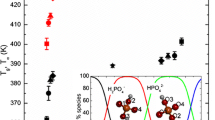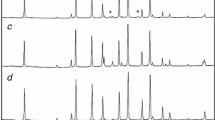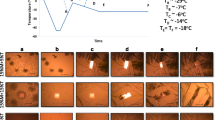Abstract
Trehalose dihydrate, on careful dehydration below its fusion point, retains its original crystal facets but becomes X-ray amorphous, an unusual example of direct crystal-to-glass transformation. From DSC studies, the glass obtained by this route seems to be of abnormally low enthalpy, but after an initial scan, the normal form of glass transition is exhibited, withT g=115‡C, a higher value than previously reported. We give a preliminary thermal and mechanical characterization of this material and find it to be a very fragile liquid. The highT g is shown to rationalize the exceptionally high water content of the trehalose+water solution that vitrifies at ambient temperature (i.e.T g=298 K), and hence helps explain its use by Nature as a desiccation protectant. The spontaneous vitrification of crystalline materials during desolvation is related to the phenomenology of pressure-induced or decompression-induced vitrification of crystals via the concept of limiting metastability.
Similar content being viewed by others
References
J. H. Crowe and J. S. Clegg, eds., Anhydrobiosis, Dowden, Hutchinson and Ross, Stroudsburg, PA 1973.
J. H. Crowe, L. M. Crowe and R. Mouradian, Cryobiology, 20 (1983) 346.
K. Bloch, in Essays in Biochemistry, Yale University Press, New Haven, CT 1994.
J. L. Green and C. A. Angell, J. Phys. Chem., 93 (1989) 2880.
B. Roser, Biopharm, 4 (1991) 47.
H. Levine and L. Slade, Biopharm., 5 (1992) 36.
B. J. Aldous, A. D. Auffret and F. Franks, Cryo Letters, 16 (1995) 181.
S. J. Hagen, J. Hofrichter and W. A. Eaton, Science, 269 (1995) 959.
S. J. Hagen, J. Hofrichter, H. F. Bunn and W. A. Eaton, Transfusion Clinique et Biologique, 6 (1995) 423.
D. Mishima, L. D. Calvert and E. Whalley, Nature, 310 (1984) 393.
X. L. Yeh, K. Samwer and W. L. Johnson, Appl. Phys. Lett., 42 (1983) 242.
R. Schwarz and W. L. Johnson, Phys. Rev. Lett., 51 (1983) 415.
W. L. Johnson, Annals NY Acad. Sci., 484 (1986) 13.
G. W. Scherer and P. C. Schultz, in Glass Science and Technology, Vol. 1, Glassforming Systems, D. R. Uhlmann and N. J. Kreidl, eds., Academic Press, NY 1983.
C. A. Angell, Science, 267 (1995) 1924.
N. Onodera, H. Suga and S. Seki, Bull. Chem. Soc. Jpn., 41 (1968) 2222.
A. Saleki-Gerhardt, J. G. Stowell, S. R. Byrn and G. Zografi, J. Pharm. Sci., 84 (1996) 318.
F. Sciortino, U. Essman, H. E. Stanley, M. Hemmati, J. Shao, G. H. Wolf and C. A. Angell, Phys. Rev. E, 52 (1995) 6484, and many refs cited therein.
Another possibility can be envisaged in which an electrochemical potential is used to remove mobile ions from a crystal structure until it destabilizes. The mobile species could be either positive ions plus compensating electrons, or small mobile cations and anions which would be removed simultaneously at opposite electrodes.
E. Y. Shalaev and F. Franks, Thermochim. Acta, 255 (1995) 49.
J. Fan, J. Green and C. A. Angell (to be published).
G. Brown et al., Acta Cryst., B28 (1972) 3154.
J. Brady, personal communication.
J. D. Ferry, Viscoelastic Properties of Polymers, 3rd ed., Wiley, NY 1980.
R. Böhmer, H. Senapati, and C. A. Angell, J. Non-Cryst. Sol., 131–133 (1991) 182.
C. T. Moynihan, P. B. Macedo, C. J. Montrose, P. K. Gupta, M. A. DeBolt, J. F. Dill, B. E. Dom, P. W. Drake, A. J. Easteal, P. B. Elterman, R. P. Moeller, H. A. Sasabe and J. A. Wilder, Ann. NY Acad. Sci., 279 (1976) 15.
L. Slade and H. Levine, Pure Appl. Chem., 60 (1988) 1841.
P. Tomasik, Adv. Carbohydr. Chem. Biochem., 47 (1939) 203.
J. Fan and C. A. Angell, Thermochim. Acta, 266 (1995) 9.
K. Ngai, Solid State Ionics, 5 (1981) 27.
Y. H. Roos, Carbohydr. Res., 238 (1993) 39.
C. J. Roberts and F. Franks, J. Chem. Soc. Faraday Trans., 92 (1996).
C. van den Berg, R. H. M. Hatley and F. Franks, Cryo Letter, 12 (1991) 113.
J. L. Green, J. Fan and C. A. Angell, J. Phys. Chem., 98 (1994) 13780.
I. E. T. Iben, D. Braunstein, W. Doster, H. Frauenfelder, M. K. Hong, J. B. Johnson, S. Luck, P. Ormos, A. Schulte, P. J. Steinback, A. H. Xie, and R. D. Young, Phys. Rev. Lett., 62 (1989) 1916.
I. V. Sochava and O. I. Smirnova, Food Hydrocolloids, 6 (1993) 513.
C. A. Angell, R. D. Bressel, J. L. Green, H. Kanno, M. Oguni and E. J. Sare, J. Food Eng., 22 (1994) 115.
C. A. Angell, J. Non-Cryst. Sol., 131–133 (1991) 13.
Previously, most hydrogen-bonded liquids had been found to be intermediate between strong and fragile in character [C. A. Angell, in Hydrogen-Bonded Liquids, J. C. Dore and J. Teixeira, eds. NATO-ASI Series, Plenum Press, NY 1990]. With four-OH groups per saccharide unit, one trehalose molecule can form H-bonds to many others in its neighborhood.
N. Karger and H.-D. Lüdemann, Z. Naturforsch. C, Biosc., 46 (1991) 313.
M. Hemmati, A. Chizmeshya, G. H. Wolf, P. H. Poole, J. Shao and C. A. Angell, Phys. Rev. B, 51 (1995) 14, 841.
B. J. Skinner and J. J. Fahy, J. Geophys. Res., 68 (1963) 5595.
C. A. Angell, Chem. Rev., 90 (1990) 523.
Author information
Authors and Affiliations
Additional information
This work was supported by the NSF under Solid State Chemistry Grant No. DMR91 08028-002.
Rights and permissions
About this article
Cite this article
Ding, S.P., Fan, J., Green, J.L. et al. Vitrification of trehalose by water loss from its crystalline dihydrate. Journal of Thermal Analysis 47, 1391–1405 (1996). https://doi.org/10.1007/BF01992835
Issue Date:
DOI: https://doi.org/10.1007/BF01992835




